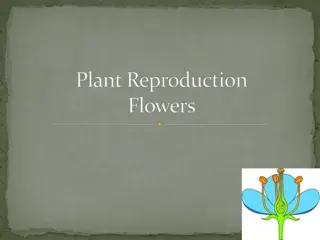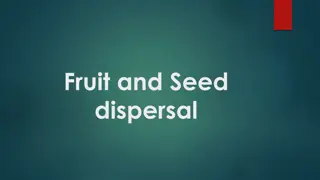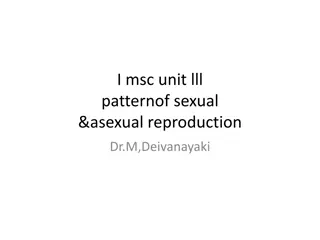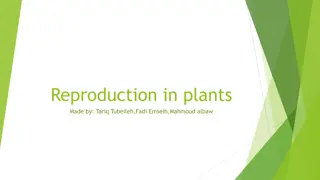Understanding Plant Reproduction: Types, Processes, and Examples
Explore the fascinating world of plant reproduction through this comprehensive guide. Learn about sexual and asexual reproduction, their differences, and examples in plants. Discover the importance of pollination, the roles of plant parts, and the various methods of asexual reproduction in plants. Enhance your understanding with embedded images, YouTube links, and detailed explanations.
Download Presentation

Please find below an Image/Link to download the presentation.
The content on the website is provided AS IS for your information and personal use only. It may not be sold, licensed, or shared on other websites without obtaining consent from the author. Download presentation by click this link. If you encounter any issues during the download, it is possible that the publisher has removed the file from their server.
E N D
Presentation Transcript
Reproduction in plants Made by: Tariq Tubeileh,Fadi Emseih,Mahmoud albaw
Check your understanding To know the types of reproduction and their examples in plants The parts of the plant and their functions How plants are pollinated (wind and insect pollination) Why are plants pollinated Defining self-pollination and cross-pollination
YouTube links: Link 1:https://www.youtube.com/watch?v=Dfvyoir_SCY Link 2:https://www.youtube.com/watch?v=fcGDUcGjcyk Link 3:https://www.youtube.com/watch?v=C3iiI-gxUo4 Link 4:https://www.youtube.com/watch?v=SiFaN2xQg5g Link 5:https://www.youtube.com/watch?v=aT-_ueLkQKw
Sexual reproduction Sexual reproduction refers to a kind of reproduction where there is the involvement of one or two organisms or individuals. After that, the gametes fuse together which results in offspring. Moreover, the offspring has different characters. Further, both male and female organisms have sexual organs. Thus, at the time of reproduction, the sexual organs of male and female organisms come in contact to complete the process.
Asexual reproduction Asexual reproduction refers to the kind of reproduction that involves only one organism. Thus, the gametes do not fuse in this process. As a result, the offspring will end up resembling exactly the parent. Further, you will notice that asexual reproduction spans a variety of methods. For instance, there is binary fission where cells simply divide in half and create a clone of the parent. Similarly, we have budding, fragmentation, parthenogenesis, and more.
Differences between Asexual and Sexual reproduction Asexual reproduction It is uniparental Gametes are not found Somatic cells of parents are involved No fertilization occurs Sexual reproduction It is usually bi-parental Gametes are formed Germ cells of parents are involved Fertilization takes place
Explaining Examples of asexual reproduction Tubers in potatoes: There are nodes or eyeballs in potato tubers where new growth sprouts. Sprouts are the new stems that are emerging from each eye and are what give life to a new plant. A sliced tuber or a complete tuber can both be used as vegetative seeds. Bulbs in onions: The bulb grows with the growth of the radicle and the flag leaves following this the true leaves emerge. Runners in strawberries: The bulb grows with the growth of the radicle and the flag leaves following this the true leaves emerge.
The parts of the plant Sepals: The outer, frequently green and leaf-like elements of the flower that envelop a budding bud. Petals: The leaves that round a flower's reproductive organs. To draw pollinators, they are frequently brightly colored or shaped differently. Stamens: The area of a flower that produces pollen, typically supported by a thin filament. Filaments: Where the pollen is produced are the protracted stalks that hold the anthers. Anther: The region of the stamen from which pollen is made. Carpels: The female reproductive system found in plants with flowers. Style: Style is the name for the stalk of the pistil. Ovary: Where ovules are generated, the pistil's expanded basal region. Ovule: The ovule is the component of flowering plants that produces seeds.
The parts of the plant Reproductive parts Stamen(male reproductive part) Pistil(female reproductive part) Anther Non-reproductive parts Sepals Petals The perianth
The difference between a insect pollinated flower and an wind pollinated flower Insect pollinated: Flowers that are pollinated by insects typically smell delicious. They feature large, brilliantly colored petals. They usually have honey in them to attract insects. They frequently create prickly, sticky pollen to help the pollen grains stick to insects' legs and bodies. Wind pollinated: Wind-pollinated plants typically lack flowers, but when they do, they tend to be small, lack fragrances and nectar, produce a lot of light pollen, have stamens and stigmas exposed to the wind to either collect or disperse pollen, and lack flower petals.
Questions to answer What is sexual reproduction? answer: What is asexual reproduction? Answer: Give me 1 similarity and 1 difference between sexual and asexual? answer:
Answer key Q1) Sexual reproduction is when the male parent's sperm fertilizes the female parent's egg during sexual reproduction, the result is an offspring that is genetically distinct from both parents. Q2) Asexual reproduction is a kind of reproduction in which a new offspring is created by a single parent. The newly created people are clones of their parents since they have the same genetic makeup and physical characteristics. Q3) Similarity: both of them perform the cell division process or mitosis for cell growth and development Difference: a sexual plant has 2 parents and an asexual plant doesn t have 2 parents they have 1 parent.
Defining cross pollination Cross-pollination, or xenogeny, happens when pollen grains are transferred between flowers of different plants. In other words, the movement of pollen from one plant's anther to another plant's stigma.
Advantages and disadvantages of self- pollination Advantages of self-pollination Disadvantages of self-pollination Self-pollination aids in preserving the genetic purity or parental characteristics of the species. The seeds are in smaller quantities. There is no need to produce a lot of pollen grains. New plant varieties cannot be created. Because the endosperm is so little, the seeds produced are feeble. It ensures seed production. If new traits are not introduced, the immunity of the progeny declines. There is less fluctuation, and with it, less ability to modify the climate. Flowers don't have to create tools to entice insect pollinators.
Advantages and disadvantages of cross- pollination Advantages of cross pollination Cross-pollination results in the development of new varieties. More substantial amounts of seeds are generated, and they are also more viable. Offspring are born healthier. Disadvantages of cross-pollination More substantial amounts of pollen grains are squandered. Cross-pollination could bring about undesired features. Pollination may not succeed due to the distance barrier.
Describing the growth of pollen tube As the pollen tube reaches the ovary, it is drawn to an ovule that has an egg cell in it. The progamic phase, which is a stage of pollen development, refers to the interval between pollination and fertilization.
These are the parts of the seeds A seed typically consists of three main parts: the embryo, the endosperm, and the seed coat. The embryo is the young plant within the seed, and it consists of several parts, including the radicle, the plumule, and the cotyledons. The endosperm is a source of nutrients for the developing embryo, and the seed coat protects the embryo from damage and dehydration. To elaborate, below are the various components of a seed: The seed's outer shell, known as the testa or seed coat, shields the interior from harm and dehydration. Cotyledon: This is the plant's developing leaf. It is the first structure to appear after the seed germinates and stores food for the growing embryo. Radicle: This is the plant's developing root. It grows downward into the earth and is the first structure to emerge from the seed during germination. Plumule: This is the plant's developing stalk. It rises into the air and is situated above the cotyledons.
Question bank What are the parts of the seed Answer: Explain the parts of the seed Answer: State one disadvantage and one advantage for cross-pollination Answer:
Explain environmental conditions that affect germination Water: Water is necessary for the germination of seeds. The seed's coat, or exterior covering, will start to enlarge after absorbing water. This enables the seed to germinate and sprout. Without sufficient water, seeds might not be able to germinate and begin to grow. But too much water can also be detrimental to seed germination since it can result in soggy soil that is devoid of the oxygen the seeds need to grow. Oxygen: For seeds to germinate, oxygen is also necessary. For cells to respire and produce energy, which is what the seed needs to start developing, oxygen is required. The seed might not be able to produce enough energy to push through the soil and begin developing if there is not enough oxygen available. So that's why In conclusion, it is critical to provide seeds with enough water, oxygen, and a sufficient temperature range in order to ensure successful germination.
notes Gametes:specialized cells for reproduction Male reproductive gamete:pollens Female reproduction gametes:ovule A baby plant is called zygote then it grows into an embryo FUSION is necessary to be stated in fertilization Each reproductive gamete has 23 in humans and the they fuse up to make up 46 The pollen makes up a tube























